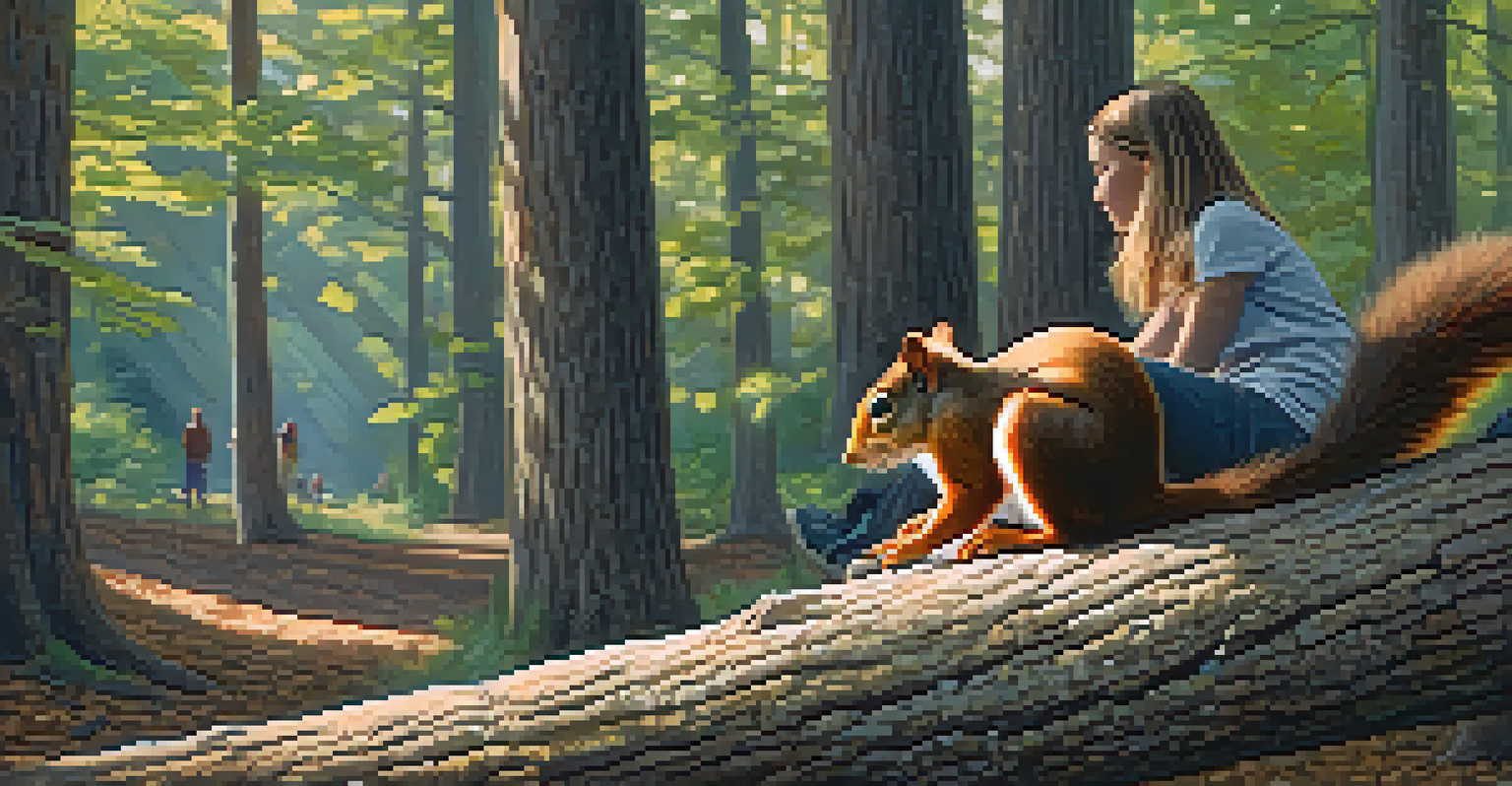Wildlife Watching: Nature's Spectacle in Local Parks

The Thrill of Wildlife Watching in Local Parks
Wildlife watching is like opening a window to nature's heart, offering a glimpse into the lives of animals that share our environment. Local parks often serve as hidden gems where various species thrive, from birds chirping in the trees to deer grazing in the meadows. This simple yet exhilarating activity allows us to connect with nature and appreciate its beauty right in our backyard.
In every walk with nature one receives far more than he seeks.
Imagine strolling through a park, the sun filtering through the leaves, as you spot a vibrant blue jay hopping from branch to branch. These moments of discovery not only ignite our curiosity but also remind us of the diverse ecosystems that exist around us. Each visit can bring a new experience, making wildlife watching an engaging and ever-changing adventure.
Moreover, wildlife watching encourages mindfulness; it invites us to slow down and observe the world around us. By taking the time to appreciate the subtle movements and sounds of nature, we cultivate a deeper understanding of our environment. This connection can inspire us to protect these precious habitats, ensuring that future generations can enjoy the same wonders.
Best Local Parks for Wildlife Watching
Finding the perfect spot for wildlife watching can enhance your experience significantly. Many local parks are designed with diverse habitats, making them ideal for spotting a variety of animals. Parks with wetlands, forests, and fields often attract different species, allowing you to witness nature's spectacle in one visit.

For example, parks like Central Park in New York or the Presidio in San Francisco boast rich biodiversity, with everything from migratory birds to playful squirrels. These spaces not only provide habitats for wildlife but also offer trails and viewing areas that make observation easier and more enjoyable. Exploring these parks can feel like stepping into a living picture book, brimming with life.
Wildlife Watching Connects Us to Nature
Engaging in wildlife watching fosters mindfulness and a deeper appreciation for the natural world around us.
Before you go, consider checking local resources or park websites for wildlife sightings and seasonal changes. Some parks even host guided tours or educational programs that can enhance your understanding of the local fauna. By choosing the right park, you're setting the stage for an unforgettable wildlife watching experience.
Best Times for Wildlife Watching
Timing can make all the difference when it comes to wildlife watching. Many animals are most active during dawn and dusk, making these the prime times for spotting creatures in their natural habitat. Early mornings can bring the delightful sounds of chirping birds, while evenings may unveil the elusive activities of nocturnal animals.
The clearest way into the Universe is through a forest wilderness.
Additionally, the changing seasons offer unique opportunities for wildlife observation. Spring, for instance, is a fantastic time to witness nesting behaviors and the arrival of migratory birds, while fall can showcase animals preparing for winter. Each season brings its own charm, transforming the landscape and the wildlife within it.
By planning your visits during these peak times, you increase your chances of encountering a variety of species. Keep in mind that patience is key; spending quiet moments in nature often pays off with exciting wildlife encounters. So, grab your binoculars and be ready to embrace the unexpected!
How to Prepare for a Wildlife Watching Trip
Preparation is essential for a successful wildlife watching trip. Start by researching the park you plan to visit, noting what animals are common and when they're most active. Bringing along field guides or wildlife identification apps can also enhance your experience, making it easier to recognize the animals you encounter.
Dressing appropriately for the weather is crucial. Opt for comfortable clothing that allows you to move freely and consider wearing muted colors to blend into the surroundings. This will help you avoid startling the wildlife and increase your chances of observing them in their natural behaviors.
Best Parks Enhance Wildlife Viewing
Choosing local parks with diverse habitats significantly improves your chances of observing a variety of wildlife.
Lastly, don’t forget essential supplies like binoculars to get a closer look, a camera to capture memories, and a notebook to jot down your observations. By being well-prepared, you set the stage for a rewarding experience that connects you deeply with nature.
Respecting Wildlife and Their Habitats
While wildlife watching can be thrilling, it’s crucial to approach it with respect for the animals and their habitats. Maintaining a safe distance is essential; getting too close can stress animals and disrupt their natural behaviors. Use binoculars or a camera with a zoom lens to observe without intruding on their space.
Additionally, be mindful of your surroundings and avoid leaving any trash behind. Litter can harm wildlife and degrade their habitats, so always clean up after yourself. Following park rules and guidelines helps ensure that these natural spaces remain healthy and vibrant for future visitors.
Lastly, consider sharing your wildlife experiences with others, promoting awareness and appreciation for nature. By encouraging responsible wildlife watching, you contribute to conservation efforts and inspire others to value the beauty of the natural world.
The Benefits of Wildlife Watching
Wildlife watching offers numerous benefits beyond the joy of seeing animals. It promotes mental well-being, as immersing oneself in nature can reduce stress and anxiety. The calming effect of observing wildlife encourages mindfulness, allowing individuals to feel more present and connected to their surroundings.
Moreover, it fosters a sense of community among fellow nature lovers. Whether you join a local wildlife group or participate in guided tours, sharing your passion for wildlife can lead to meaningful connections with others. This sense of camaraderie enhances the overall experience and encourages collective action for conservation.
Preparation is Key for Success
Thoroughly preparing for a wildlife watching trip, including research and necessary supplies, ensures a rewarding experience.
Lastly, wildlife watching can spark a desire to learn more about ecology and conservation. Understanding the delicate balance of ecosystems can inspire individuals to advocate for the protection of wildlife and their habitats, fostering a deeper appreciation for nature's wonders.
Getting Started with Wildlife Watching
If you're new to wildlife watching, don’t worry—getting started is easier than you might think! Begin by visiting your local parks and simply observing your surroundings. Take note of the sounds and movements you see; sometimes, just sitting quietly can reveal the hidden wonders of nature.
Consider joining a local wildlife watching group or attending workshops to learn from experienced enthusiasts. These groups often organize outings that provide valuable insights into the best practices for observing wildlife. You'll also meet like-minded individuals who share your passion for nature.

Lastly, keep an open mind and be patient. Wildlife watching is as much about the journey as it is about the destination. Embrace the unexpected moments and enjoy the beauty of nature—it’s all part of the adventure!